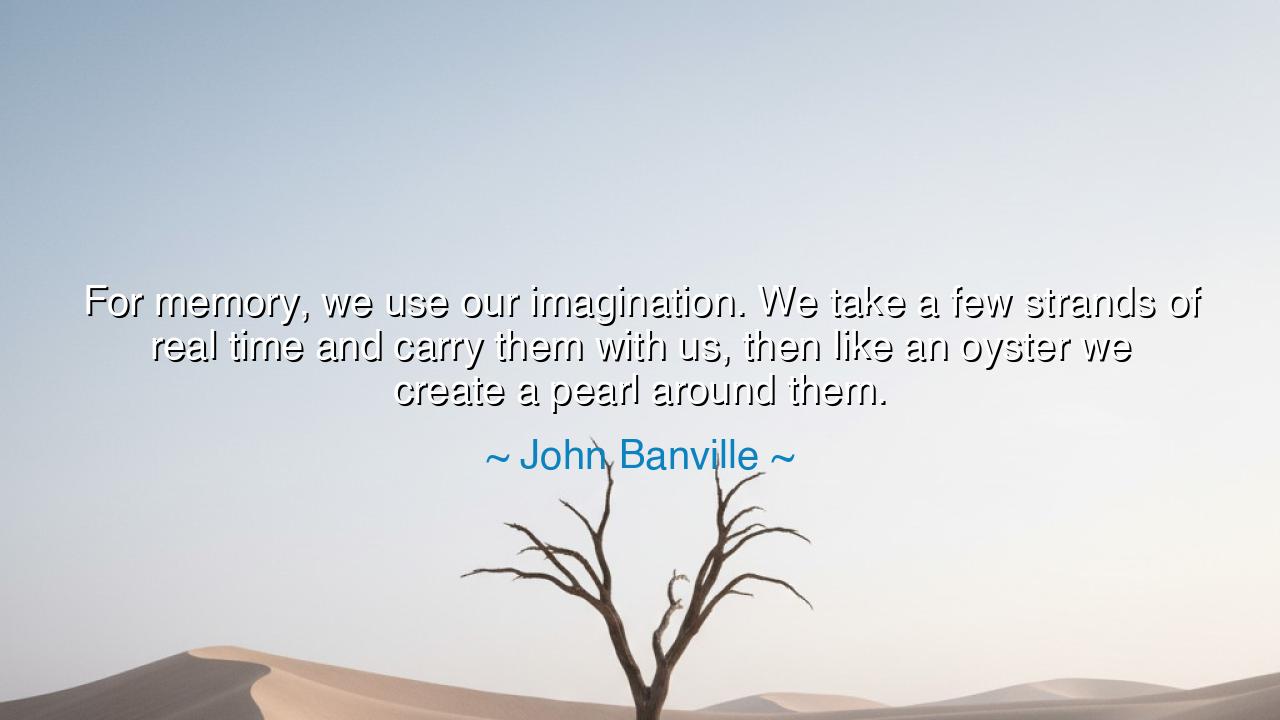
For memory, we use our imagination. We take a few strands of real
For memory, we use our imagination. We take a few strands of real time and carry them with us, then like an oyster we create a pearl around them.






When John Banville wrote, “For memory, we use our imagination. We take a few strands of real time and carry them with us, then like an oyster we create a pearl around them,” he revealed a profound truth about the nature of memory and the mysterious partnership it shares with imagination. His words remind us that what we remember is not a perfect mirror of the past, but a living creation—part fact, part dream, part longing. The mind, like the sea, is never still. It rolls and reshapes what it holds, polishing pain into beauty, softening grief into wisdom. In this way, memory is not a recording—it is an act of creation, and every one of us is both the oyster and the pearl-maker of our own story.
In the depths of Banville’s imagery lies both poetry and science. The origin of his quote reflects his lifelong meditation on the fragility of truth and time. As a novelist, Banville often explored how human beings reconstruct the past through emotion and imagination. Modern neuroscience affirms what his artistic intuition knew: that memory is not fixed, but fluid; each recollection alters the original, as if the act of remembering were also an act of rewriting. The mind does not merely store—it invents. Thus, the imagination becomes the craftsman of our inner history, turning fragments of real experience into stories that comfort, explain, or justify.
The metaphor of the oyster is a perfect symbol of this process. The oyster begins with something small and raw—a grain of sand, an irritant, a wound. Around this fragment, it secretes layers of nacre, transforming discomfort into beauty. So too do we, when we remember. The raw truth of our lives—the events themselves—are only the seed. Around them, the imagination wraps layer upon layer: emotion, meaning, regret, hope, and sometimes even illusion. What remains is no longer the grain, but the pearl—a creation both real and unreal, both memory and art. This is how the heart survives what the mind cannot bear.
Consider the life of Anne Frank, the young girl who wrote her diary while hiding during the terror of war. Her words are born of memory and imagination interwoven. Though she lived in a confined space, her mind roamed freely, shaping her experiences into reflections luminous with courage and hope. Her diary is not only a record—it is a transformation. Through her writing, she turned fear into understanding and confinement into meaning. In her act of remembering, she created a pearl that has touched the souls of millions. So too does Banville remind us that in every person lies this same alchemy: the ability to turn suffering into beauty through the imagination of memory.
This truth holds a deep warning as well. For while imagination gives memory its brilliance, it can also distort. We may polish the past until it gleams too brightly, forgetting the roughness that once gave it shape. We may build myths around ourselves—stories of triumph or of tragedy—that are comforting but false. Therefore, wisdom demands balance: to recognize that what we remember is not pure reality, but the mind’s own creation. To know this is not to despair, but to understand. It allows us to see that every memory, like every pearl, carries both truth and illusion, and that the beauty of life lies in this mingling.
Banville’s reflection also speaks to the redemptive power of creation. The imagination, though it reshapes the past, does so with purpose—it helps us endure, heal, and grow. The poet remembers a lost love and writes a verse that redeems the pain. The soldier recalls his comrades and builds a monument. The parent tells a story of childhood and, in telling, passes light into the future. Through memory shaped by imagination, each of us becomes a maker of meaning. The past ceases to be a weight and becomes a wellspring, flowing endlessly into the present.
So, my listener, learn this sacred art: do not fear your memories, and do not cling to them as though they were stone. Let them live, let them breathe. Take the raw fragments of your life—the joys, the wounds, the regrets—and, like the oyster, shape them into pearls of understanding. Reflect upon them, but also imagine what they could mean. Speak them, write them, sing them, until they shine with the light of your own soul.
For as John Banville teaches, memory and imagination are not opposites but partners in the grand act of living. One gathers the fragments of time; the other gives them form and purpose. Together they make the story of who we are—not as history records us, but as the spirit remembers. And in that living story, shaped by the tenderness of imagination, we find not only remembrance, but redemption.






AAdministratorAdministrator
Welcome, honored guests. Please leave a comment, we will respond soon